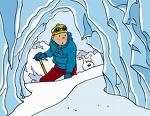 The latest satellite data shows that this summer’s snowmelt in northern Greenland was “extreme”, according to Marco Tedesco, assistant professor of Earth & Atmospheric Sciences at The City College of New York. From the press release:
The latest satellite data shows that this summer’s snowmelt in northern Greenland was “extreme”, according to Marco Tedesco, assistant professor of Earth & Atmospheric Sciences at The City College of New York. From the press release:
“Having such extreme melting so far north, where it is usually colder than the southern regions is extremely interesting,” Professor Tedesco said. “In 2007, the record occurred in southern Greenland, mostly at high elevation areas where in 2008 extreme snowmelt occurred along the northern coast.”
Melting was most pronounced near Ellesmere Island, where ice sheet collapses were observed, and around the Petermann glacier, which is also shedding ice. Melting lasted 18 days longer than average in these areas, and the melt index (area times days) was three times higher than the 1979-2007 average for the region.
Underlining the dramatic changes being seen in the far north, the National Oceanic & Atmospheric Administration (NOAA) released its second Arctic Report Card earlier this week…
This year’s report covers 2007 (with some sea ice comment on 2008), noting that Greenland lost 100 cubic kilometres of ice, permafrost continues to melt, the ocean warms, and the climate is changing.
Autumn temperatures are at a record 5º C above normal, due to the major loss of sea ice in recent years which allows more solar heating of the ocean. Winter and springtime temperatures remain relatively warm over the entire Arctic, in contrast to the 20th century and consistent with an emerging global warming influence.
Worth reading the report card in full, particularly if you’ve been following the sea ice melt – the sections on ocean and sea ice are useful summaries of what’s been going on. Joe Romm has a good precis at Climate Progress; New Scientist, Reuters and AP cover the news. See also: Mark Serreze and Julienne Stroeve’s look back over the 2008 melt at Nature Reports: Climate Change.
Adding colour to this picture, the Toledo Blade (a very fine name for a newspaper) has a three part series on the climate changes being seen on the world’s largest island, and the Guardian offers a trailer for a new documentary on Greenland and climate change.
A quick roundup of other Arctic news: Mauri Pelto provides a good overview of the various factors driving ice sheet losses at Real Climate, the BBC visits an Alaskan village experiencing rapid shoreline erosion as permafrost melts, a new study finds that permafrost could hold twice as much carbon as previously thought, a NASA study finds increased storminess in the Arctic, and Hans Schellnhuber, head of the Potsdam Institute warns that “We now have to expect that the sea level will rise by a metre this century”, according to Earth Times.
Good listening: Radio NZ National’s science programme Our Changing World (Oct 16) which has an interview with Lonnie Thompson and his equally expert partner, Ellen (stream, podcast available).
